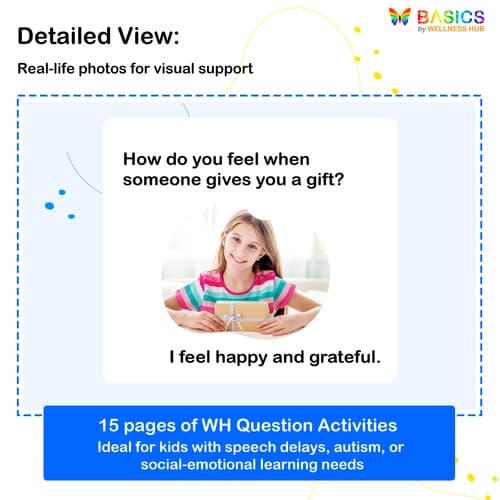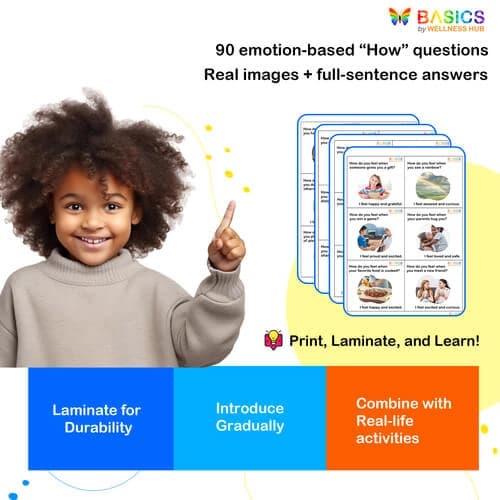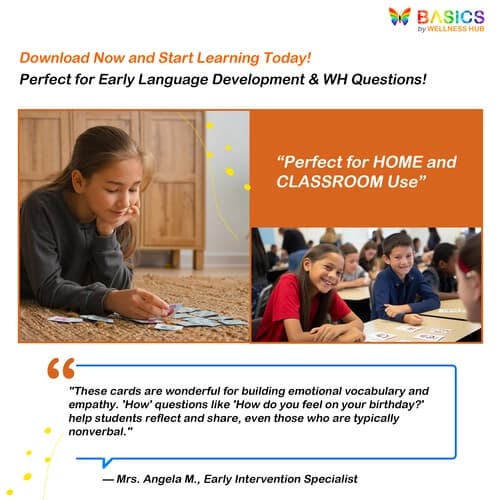


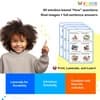
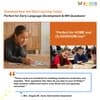
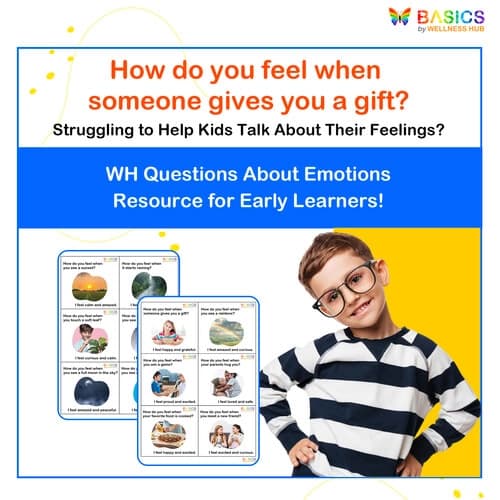
How Do You Feel? WH Questions About Emotions (Printable PDF)
₹80
₹160
50% off
0 (0 ratings)
Grade Levels
Pre-K - Grade 2 (Ages 4-8)
Content Overview
Format: Printable PDF, Total Pages: 15, Features: 6 feeling-based “How” questions per page with real images and full-sentence answers
Categories
Pages from the Resource
This printable PDF includes 90 “How do you feel?” questions to help children identify, express, and understand emotions across daily life, social situations, and new experiences. Each question is paired with a real photo and a full-sentence answer to build emotional vocabulary, sentence structure, and self-awareness. Ideal for speech therapy, SEL lessons, and special education.
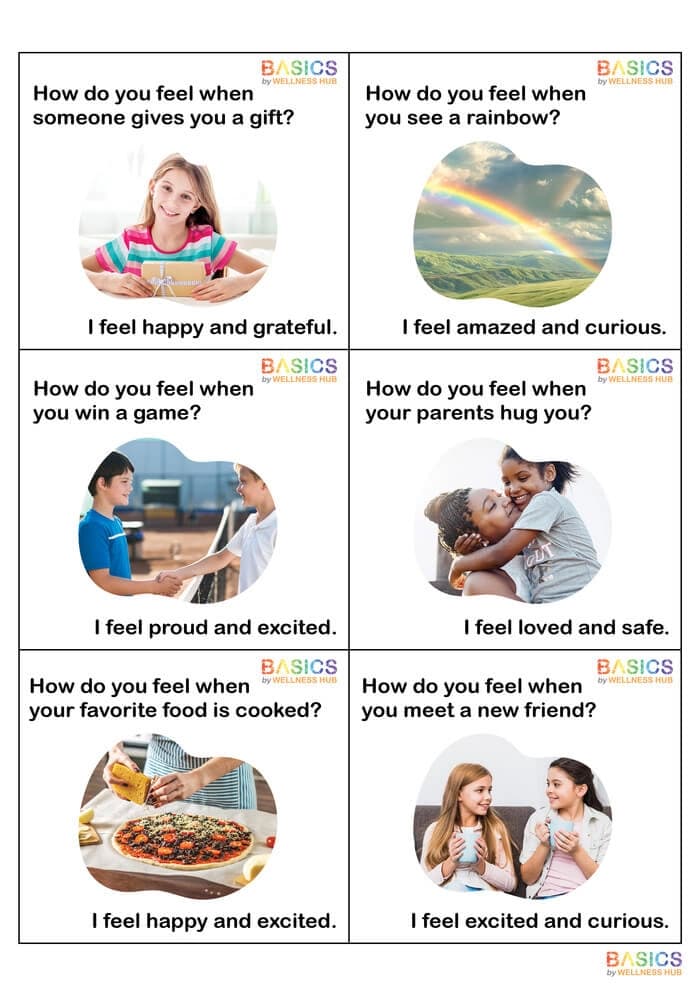
Page 1
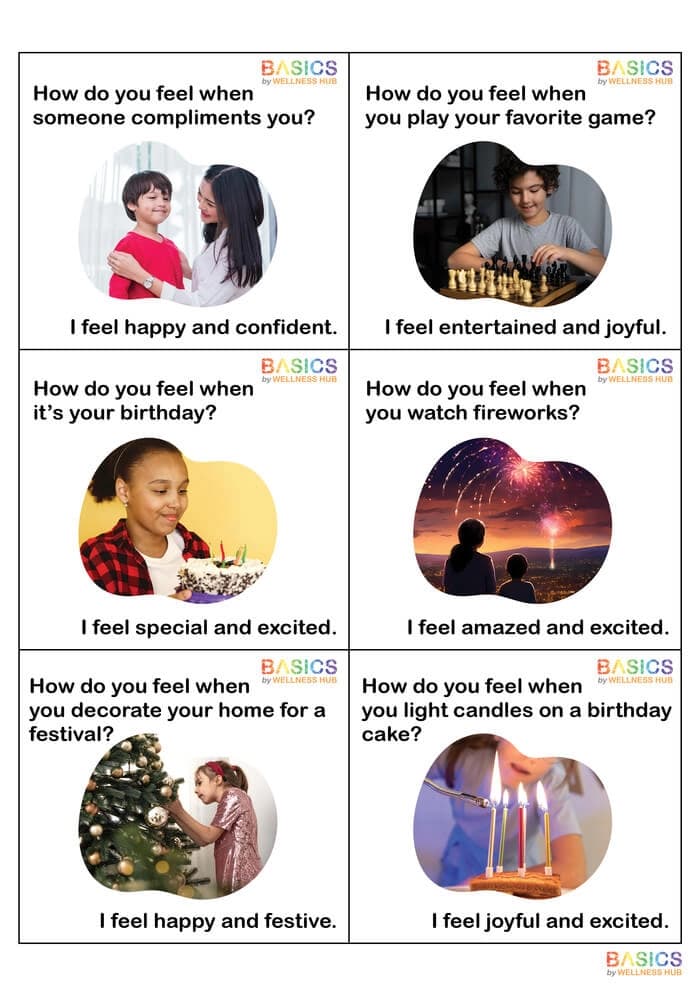
Page 2
What Users Say
0
0 ratings
5
0+
4
0+
3
0+
2
0+
1
0+
5 Stars
Product is Good to use.
1 year ago
Varsha Parent
Similar Products
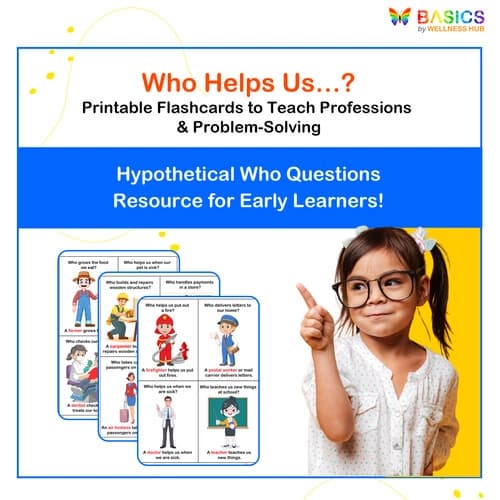
Hypothetical Who Questions – Professions Flashcards for Kids (Printable PDF)
₹ 80.00
₹ 160.00
50% off
4.9 (56 ratings)

Emotions Flashcards for Kids: Free Printable PDF
FREE
₹160
50% off
4.8 (44 ratings)

Conversation Cards - Basic Emotions: Questions to Help Kids Express Feelings
₹ 80.00
₹ 160.00
50% off
4.6 (52 ratings)
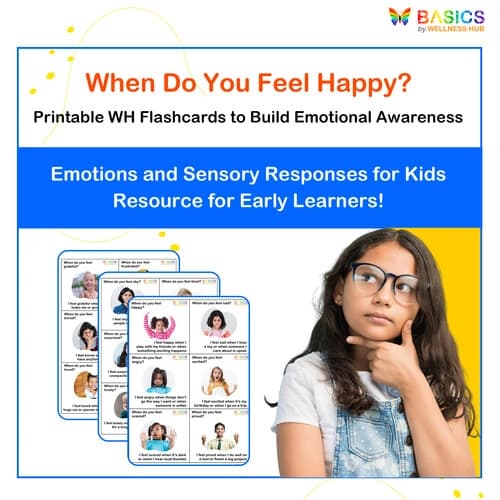
When Questions Flashcards – Emotions and Sensory Responses for Kids (Printable PDF)
₹ 80.00
₹ 160.00
50% off
5.0 (44 ratings)

4-Step Sequencing Cards: Printable PDF for Understanding Crying & Emotions
₹ 80.00
₹ 160.00
50% off
4.8 (46 ratings)
About the Product
Introduction
Learning to identify and express emotions is a key part of a child’s social and emotional development. But many children—especially those with speech delays, autism, or language processing challenges—struggle to name their feelings or talk about how they feel in different situations.
“How Do You Feel?” WH Questions About Emotions is a 15-page printable PDF designed to help children answer feeling-based “how” questions using real-life images and age-appropriate, full-sentence answers. The resource includes 90 questions across a wide range of situations such as social interactions, daily routines, new experiences, nature, and helping others. It provides essential support for building emotional vocabulary, self-awareness, and verbal expression.
This is a powerful tool for speech therapy, SEL instruction, special education, and general early childhood learning—giving children the words and confidence to talk about their inner world.
Product Details
- Resource Type: Printable PDF
- Total Pages: 15
- Questions Per Page: 6
- Total Questions: 90
- Focus Areas:
- Positive emotions (e.g., happy, excited, proud)
- Negative emotions (e.g., sad, angry, nervous)
- Social feelings (e.g., shy, curious, thankful)
- Everyday life situations (e.g., trying something new, meeting someone, getting help)
- Positive emotions (e.g., happy, excited, proud)
- Question Format Example:
- “How do you feel when someone gives you a gift?”
- “I feel happy and grateful.”
- Visuals: Real photographs representing each scenario
- Answer Style: Full-sentence responses modeling appropriate emotional expression
- Design: Clean, child-friendly layout for printing or digital use
- Compatibility: US Letter / A4
Educational Benefits
✅ Enhances Emotional Awareness
Children learn to identify and label a wide range of feelings—an essential step toward emotional regulation and self-understanding.
✅ Supports WH-Question Comprehension
This resource focuses on the often challenging “How do you feel?” question format, helping children improve their comprehension and expression.
✅ Encourages Full-Sentence Expression
Each prompt includes a modeled answer using a full sentence, promoting correct sentence structure, verb usage, and emotional vocabulary.
✅ Builds Social-Emotional Skills
By exploring feelings in daily life, social settings, and unexpected situations, the resource helps children practice empathy, perspective-taking, and self-reflection.
✅ Supports Diverse Learning Needs
Ideal for:
- Children with autism spectrum disorder
- Speech and language delays
- Emotional regulation challenges
- English language learners
- Use in SEL groups, speech therapy, homeschool, and inclusive classrooms
Instructions for Use
1️⃣ Print or Use on a Device
- Download and print the full set or specific pages based on themes (e.g., positive emotions, social situations).
- Use on-screen via tablet, laptop, or in teletherapy sessions.
2️⃣ Introduce the Concept
- Show the image and read the question aloud:
“How do you feel when you win a game?” - Discuss the picture and possible answers.
- Read or model the full-sentence response:
“I feel proud and excited.”
3️⃣ Encourage Verbal Participation
- Ask the child to repeat the answer.
- For older or more verbal children, ask them to give a different answer or talk about why they feel that way.
- For beginners or non-verbal children, use picture-supported choices or gestures.
4️⃣ Expand the Conversation
- Use the opportunity to ask follow-up questions like:
- “Have you ever felt that way?”
- “What else might make you feel excited?”
- This builds emotional generalization and encourages personal connections.
5️⃣ Create a Daily Feelings Routine
- Select 1–2 cards each morning or evening.
- Use them as a conversation starter about how the child is feeling or reflecting on the day.
- Great for journaling, calm-down corners, or family discussions.
Activities Using the Resource
These activities are designed to help children actively engage with the resource and internalize emotional vocabulary, sentence structure, and self-expression in meaningful ways.
1. Feelings Role-Play
Objective: Support emotional understanding through experiential learning
How to Use:
- Read a question aloud, such as: “How do you feel when you meet someone new?”
- Ask the child to act out the emotion (e.g., smile shyly, wave excitedly).
- Encourage them to say the full response: “I feel excited and a little shy.”
- Discuss how different people may feel differently in the same situation.
2. Draw Your Feeling
Objective: Foster visual expression and internal reflection
How to Use:
- After reading a question, ask the child to draw themselves in that situation.
- Example: “How do you feel when you win a game?” → Child draws themselves holding a trophy and smiling.
- Label the emotion together, or write a sentence below the picture.
3. Emotion Sorting Game
Objective: Develop emotional categorization and vocabulary expansion
How to Use:
- Print several cards and mix them.
- Ask the child to sort them into categories:
- Positive Feelings (e.g., excited, proud)
- Uncomfortable Feelings (e.g., nervous, sad)
- Mixed Feelings (e.g., shy + happy)
- Positive Feelings (e.g., excited, proud)
- Discuss how it's okay to feel more than one thing at a time.
4. My Feelings Story
Objective: Build narrative and expressive language skills
How to Use:
- Choose 2–3 questions and ask the child to create a mini story:
- “One day, someone gave me a gift. I felt happy and grateful...”
- Have them draw the story or tell it aloud.
- This helps with sequencing, empathy, and personal connection.
5. Feelings Journal Prompt
Objective: Integrate emotional awareness into daily routines
How to Use:
- Use a different card each morning or evening as a journal question:
- “How do you feel when it rains all day?”
- Let the child talk, write, or draw their answer.
- This activity promotes self-reflection and language development.
FAQs
Q1: What age group is this best for?
A1: This resource is ideal for ages 4–8, but it can be adapted for older children with special needs, language delays, or those learning English as a second language.
Q2: Can this be used with children who are non-verbal or minimally verbal?
A2: Yes. You can pair this resource with AAC devices, emotion cards, or allow for pointing, drawing, or gesturing to indicate answers. The real images are especially helpful for visual learners.
Q3: Is this suitable for speech therapy or SEL groups?
A3: Absolutely. It’s designed to target WH-question answering, emotional labeling, self-expression, and social-emotional learning. SLPs, special educators, and counselors all find it effective.
Q4: How do I use this with ESL or ELL students?
A4: Use the images to explain new vocabulary and model the full-sentence response. Students can repeat, match, or act out feelings to reinforce comprehension in a supportive, visual context.
Q5: Can this be used for individual or group work?
A5: Both! It works well in one-on-one therapy, small group SEL activities, or even whole-class discussions. The flexibility makes it easy to adapt to your needs.
Usage Rights and Restrictions
You May:
- Use the resource in your classroom, therapy sessions, or home
- Share digitally during teletherapy or screen-based instruction
- Print unlimited copies for your individual use or direct students/clients
- Recommend and share the product link with others
You May Not:
- Upload or post the file publicly (e.g., blogs, forums, shared drives)
- Sell or include the resource in paid courses, apps, or bundles
- Modify and redistribute as your own
- Distribute outside your direct client/classroom use without permission
Need licensing for multiple classrooms or a clinic-wide use? Reach out for a custom license.
Conclusion
“How Do You Feel? WH Questions About Emotions” is more than just a printable—it’s a powerful bridge between language learning and emotional development. With 90 thoughtfully crafted questions, real-life photos, and clear modeled answers, children gain the tools to name, process, and communicate how they feel.
Perfect for speech therapy, SEL, autism support, ESL classrooms, and more, this resource helps children move from “I don’t know” to “I feel…”—with confidence.
Download now and help children explore the world of emotions—one question at a time.
